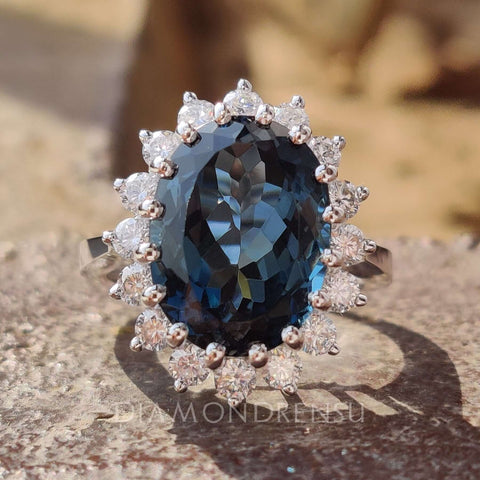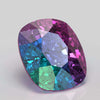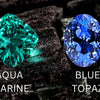If you were born in April, your birthstone is the diamond. Diamonds are renowned for their unmatched hardness and brilliance, qualities that have made them a symbol of enduring love and commitment. Beyond their aesthetic appeal, diamonds are also the hardest known natural material on Earth, making them highly valued not only in jewelry but in industrial applications as well.
Understanding the significance of your birthstone can give you a greater appreciation for its beauty and cultural relevance. The tradition of birthstones dates back to ancient times, where specific gemstones were associated with different months of the year, often connected to the zodiac or believed to hold certain powers. For April, the diamond's strength and clarity are seen as emblematic of resilience and purity.
When you wear a diamond, you are not just accessorizing with a stunning gem; you are also carrying with you a piece of history. Throughout time, diamonds have been adorned by royalty and coveted by collectors, symbolizing wealth and status. Today, diamonds continue to be celebrated for their timeless elegance and are a popular choice for engagement rings and other significant pieces of jewelry.
Birthstone Basics

Birthstones are gems assigned to each month of the year, often embraced for their beauty and symbolism.
What is a Birthstone?
A birthstone is a gemstone that represents a person's month of birth. These stones carry a wealth of symbolism, reflecting traits believed to be linked to those born in that month. For instance, the April birthstone is traditionally a diamond, which signifies purity and strength.
History of Birthstones
Gemstones have been used to signify birth months for centuries, with the history of birthstones traceable back to ancient civilizations. They believed that these gemstones held power, provided luck, and offered healing properties. The tradition has evolved, but many still cherish birthstones for their symbolism and personal significance.
April's Birthstone
In April, the birthstone that represents your birth month is none other than the diamond—a symbol of unmatched strength and clarity.
The Diamond as a Symbol
Diamonds have long been revered as a representation of strength and love. Not only are they believed to bring courage to those who wear them, but diamonds, associated with April as the April birthstone, also carry significance in the way of innocence and purity. Their resilient nature further ties into the enduring quality of love, hence making them a popular gemstone for engagement rings and romantic gifts.
Characteristics of Diamonds
| Characteristic | Description |
|---|---|
| Hardness | Hardest known natural material; rated 10 on the Mohs scale. |
| Color | Colorless to shades of yellow, brown, or rare fancy colors. |
| Transparency | Transparent to translucent. |
| Brilliance | Exceptional brilliance due to high refractive index and dispersion. |
| Luster | Adamantine luster with strong light reflection. |
| Dispersion | High dispersion creating the play of colors (fire). |
| Cut | Cut influences the diamond's sparkle and overall appearance. |
| Carat | Measurement of weight; one carat is equivalent to 0.2 grams. |
| Clarity | Degree of imperfections or inclusions; graded from Flawless to Included. |
| Shape | Various shapes including round, princess, emerald, and more. |
It is their exceptional durability and clarity that make diamonds both a practical choice and a profound symbol for those born in April. Their ability to endure is symbolic of a steadfast nature, and their sparkle is a testament to the inner brilliance that April-born individuals are said to possess.
Colors and Varieties

April's birthstone, the diamond, is traditionally celebrated for its sparkling transparency, but it also comes in a diverse palette of colors. Understanding the color spectrum and the variety of available diamonds can help you appreciate the uniqueness of your birthstone.
Color Spectrum of Diamonds
Diamonds are not just colorless; they actually span a wide array of colors. Colorless diamonds are the most widely recognized, and their lack of color is a sign of their purity and rarity. However, diamonds also come in vivid hues—fancy color diamonds—that include yellow, blue, pink, green, and even red. The color in these gems is the result of trace elements or structural anomalies within the crystal lattice.
Famous Diamond Colors
While colorless diamonds have become synonymous with classic beauty, fancy color diamonds have caught the eye of collectors and enthusiasts. For example, blue diamonds contain boron, which traps blue light. The famous Hope Diamond is an example of this rare blue shade. Pink and yellow diamonds owe their hues to variations in the crystal structure during formation, often referred to as plastic deformation and the presence of nitrogen, respectively.
Alternative April Stones
For those seeking unconventional options, April's birthstone variety extends beyond diamonds. Sapphire, a typically blue gem, and Opal, known for its play-of-color, are also historically associated as April birthstones. While sapphire mostly comes in blue, it exists in yellow, pink, and green as well. Opal, on the other hand, offers a kaleidoscope of colors, reflecting light in remarkable patterns unique to each stone.
Sourcing Diamonds

When you consider where diamonds come from, it's essential to acknowledge that these precious stones hail from deep within the Earth, brought to the surface through volcanic eruptions over millions of years. Today, major mines around the globe extract these gems, with each sourcing location bearing its own unique set of ethical considerations.
Major Diamond Mines
Major mines across the world provide an abundant supply of diamonds. In Russia, the Mirny Mine is one of the largest diamond deposits, known for its rich resources. Australia contributes considerably with the Argyle mine, historically known for its fancy colored diamonds, particularly pink and red hues.
South Africa is noteworthy for its extensive history in the diamond industry with the famous Kimberley Mine. The Golconda diamond mines in India were historically significant and famous for exquisite diamonds, although these mines are no longer active. Brazil also plays a role in diamond production, despite it being more famous for colorful gemstones. Brazilian diamonds have an impactful history with discoveries dating back to the 18th century.
Ethical Considerations
Ethical considerations in diamond sourcing have gained prominence in light of concerns over conflict diamonds, or "blood diamonds", which fund violence in war-torn areas. Today, the Kimberley Process is a certification scheme that aims to prevent conflict diamonds from entering the mainstream market.
Consumers are increasingly seeking ethically sourced diamonds, prompting suppliers to provide assurances regarding the origin of their diamonds. Additionally, labor conditions and environmental sustainability are influential factors guiding ethical sourcing methodologies. Each of these elements assures you that your April birthstone aligns with values of responsible stewardship and human rights.
Diamond Jewellery

Diamond jewellery represents sophistication and timeless beauty. The April birthstone is a popular choice for jewelry items such as rings, necklaces, and bracelets, serving both as a symbol of love and a treasured fashion accessory.
Selecting Diamond Jewelry
When you're selecting diamond jewelry, consider the four C's: Carat, Clarity, Color, and Cut. These factors help determine the value and quality of a diamond. For engagement rings and wedding rings, selecting a diamond with higher gradings in these areas typically denotes a more stunning and valuable piece. But remember, it's important to choose a style that resonates with your personal taste and fits your lifestyle.
Types of Diamond Jewelry
- Rings: From classic solitaires to elaborate halo designs, diamond rings come in various settings and styles, fit for many occasions.
- Earrings: Diamond earrings add a touch of elegance to any outfit. You can choose from studs, drops, or hoop styles.
- Necklaces: A diamond necklace, such as a simple pendant or a luxurious tennis style, can serve as a striking centerpiece to your wardrobe.
- Bracelets: Diamond bracelets range from delicate bangles to statement pieces, providing a touch of sparkle on your wrist.
Caring for Diamond Jewelry
To maintain the brilliance of your diamond jewelry, regular cleaning is essential. Use a soft brush and soapy water to gently clean your pieces. It's vital to have your diamond jewelry, especially engagement and wedding rings, inspected by a professional jeweler annually to check for loose settings or damage. When not wearing your jewelry, store it separately to prevent scratches or other wear and tear.
Diamond Care

Diamonds, renowned for their exceptional hardness and brilliant crystal structure, require proper care to maintain their sparkle. Adhering to effective cleaning methods can ensure that your April birthstone remains as captivating as the day you acquired it.
Maintaining Brilliance
To preserve your diamond's brilliance, it is essential to keep it free from skin oils, cosmetics, and other substances that can diminish its shine. Here are some key steps you can take:
-
Everyday Care: Handle your diamond sparingly, as your fingers provide enough oil to alter the way your diamond looks. Be sure to remove your diamond jewelry before engaging in strenuous activities that could expose it to scratches or harsh impacts.
-
Home Cleaning: Once a week, soak your diamond in a mixture of warm water and mild dish soap. Gently brush the stone with a soft toothbrush, paying close attention to the underside of the diamond where grime can collect.
Professional Cleaning

Annual professional cleanings are recommended to ensure the enduring beauty of your diamond. During a professional cleaning:
-
Inspection: Your jeweler will inspect your diamond for any potential issues, such as loose settings or signs of wear.
- Expert Care: The jeweler will use specialized equipment to remove any built-up residue and bring out the natural luster of your diamond. This might include steam cleaning or ultrasonic cleaners that can dislodge hidden dirt without harming the crystal.
By following these guidelines, you can keep your April birthstone in immaculate condition, shining bright for years to come.
Cultural and Mythological Significance

As your April birthstone, the diamond is not just a symbol of enduring beauty, but it also carries a rich tapestry of cultural and mythological significance woven through ancient lore and nobility.
Diamonds in Ancient Lore
In the depths of ancient history, diamonds were treasured for their brilliance and believed to hold healing powers and offer protection. The Greeks revered diamonds as the tears of gods or splinters from falling stars, imbued with qualities that could ward off the evil eye. Legends from Hindu mythology also placed diamonds in the eyes of statues, signifying their heavenly origins, suggesting they held the power to influence the longevity and wellbeing of those who possessed them.
Diamonds and Nobility
The association of diamonds with wealth and status is prominently seen in the courts of nobility, especially in the case of King Louis XIV of France. Known as the Sun King, his affinity for these stones was so strong that he even created a special role of the 'diamond king' to oversee his collection. Royalty and the wealthy often used diamonds as a statement to indicate their power and affluence. The sheer rarity and cost of diamonds made them an exclusive asset, reserved for high status individuals, marking their prominence within society.
Diamonds in Contemporary Use
While diamonds have been treasured for centuries, their role in modern society extends beyond mere decoration. Today, you'll find diamonds centered at the heart of investment portfolios and as stalwart symbols in matrimonial traditions.
Investment and Trade
Diamonds have been considered a sign of wealth since the time of King Louis XIV of France, known for his lavish taste. In the contemporary marketplace, they hold a significant role as investment pieces. Trading in diamonds is commonplace, with quality stones often retaining or increasing in value over time. The criteria for investing in diamonds are stringent, focusing on the four Cs: Cut, Clarity, Color, and Carat weight.
Investors and connoisseurs alike seek out pieces with impeccable craftsmanship and rarity, which often command higher prices on both the private and auction markets.
Symbol of Commitment
Diamonds, renowned for being unbreakable, symbolize endurance and everlasting love, making them the stone of choice for an engagement ring. Your diamond engagement ring serves as an enduring commitment, a tradition believed to have been started by the Archduke Maximilian of Austria in 1477. As for wedding anniversaries, diamonds are the hallmark gift for the 60th and 75th years, further solidifying their status as the emblem of eternal devotion. Whether as a simple solitaire or encrusted in an elaborate setting, a diamond ring signifies a significant milestone in your relationship.
Frequently Asked Questions
In this section, you'll find detailed answers to common queries about April's birthstones, offering clarity on their significance and characteristics.
What are the two gemstones commonly associated with the month of April?
April is uniquely associated with diamonds, renowned for their clarity and strength. However, some traditions also recognize clear rock crystal as an alternative April birthstone.
Which stone is considered the official birthstone for those born in April?
The official birthstone for those born in April is the diamond, a symbol of enduring love and strength.
Why has the diamond been selected as the birthstone for the month of April?
Diamonds have been chosen as the birthstone for April due to their unmatched hardness and brilliance, reflecting the qualities of resilience and purity that are said to be imbued in those born in this month.
Can you provide information on alternative April birthstones besides diamond?
Aside from the diamond, clear rock crystal is sometimes considered an alternative birthstone for April, offering a more accessible option while still representing clarity.
How does the symbolism of the diamond relate to April birthstone traditions?
The symbolism of the diamond in April birthstone traditions is closely tied to its qualities of strength and invincibility, often believed to bring courage and fortitude to individuals born in this month.
What is the significance of the birth flower for April, and how is it connected to the birthstone?
April's birth flower, the daisy, symbolizes innocence and purity, which complements the clarity and strength of the diamond, integrating floral and gemstone symbolism into a harmonious representation of April's essence.
Checkout some of our top collections:











